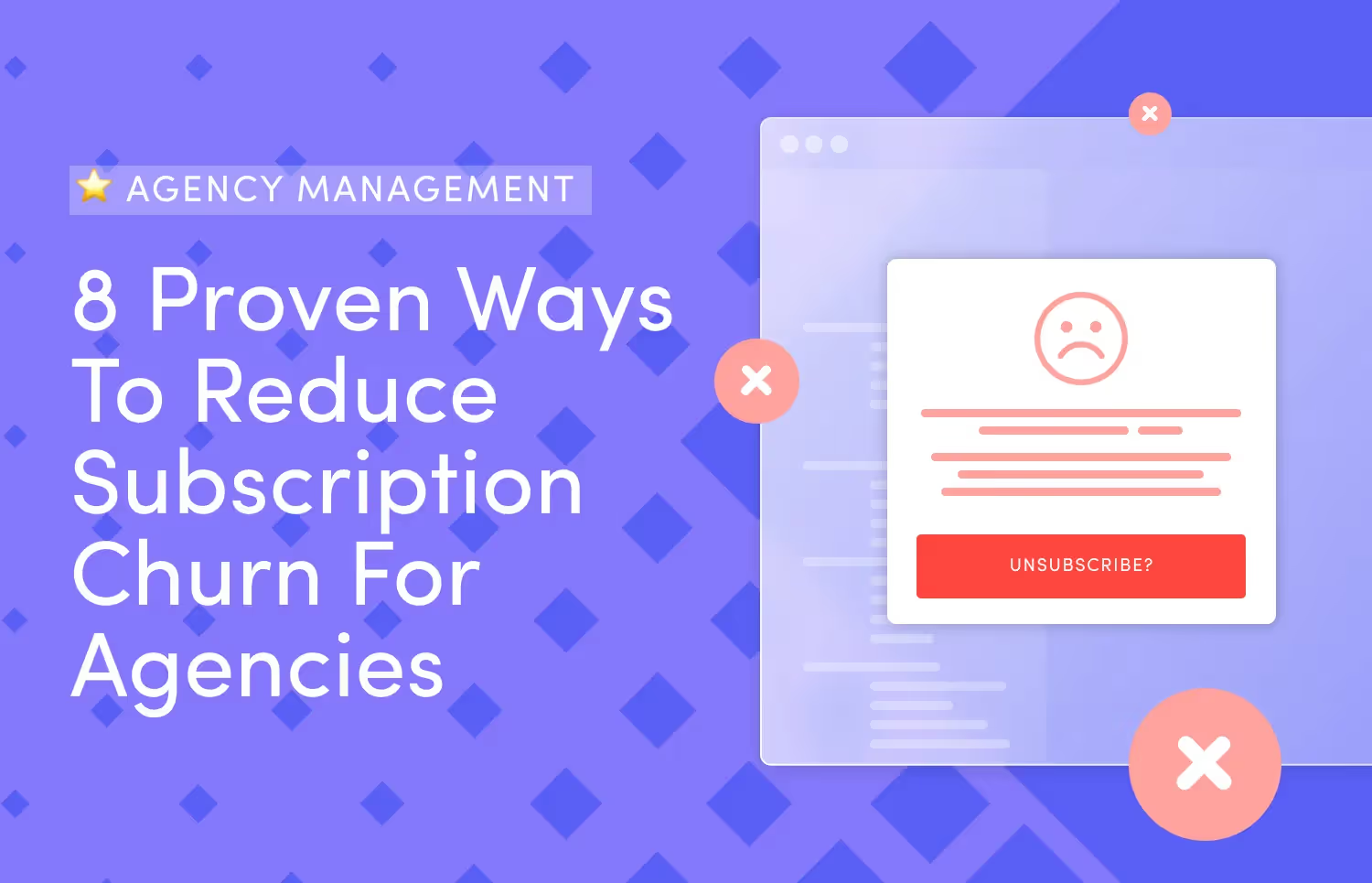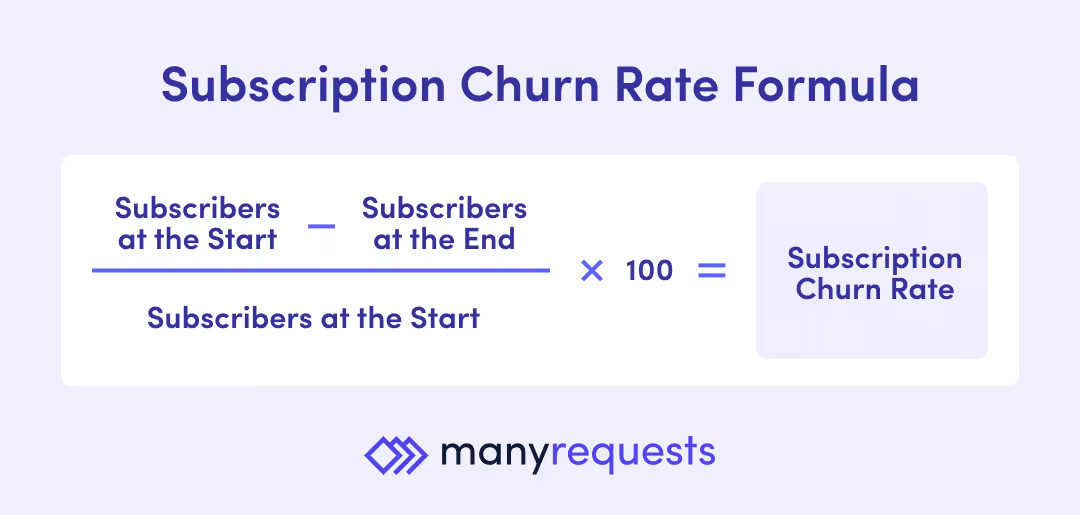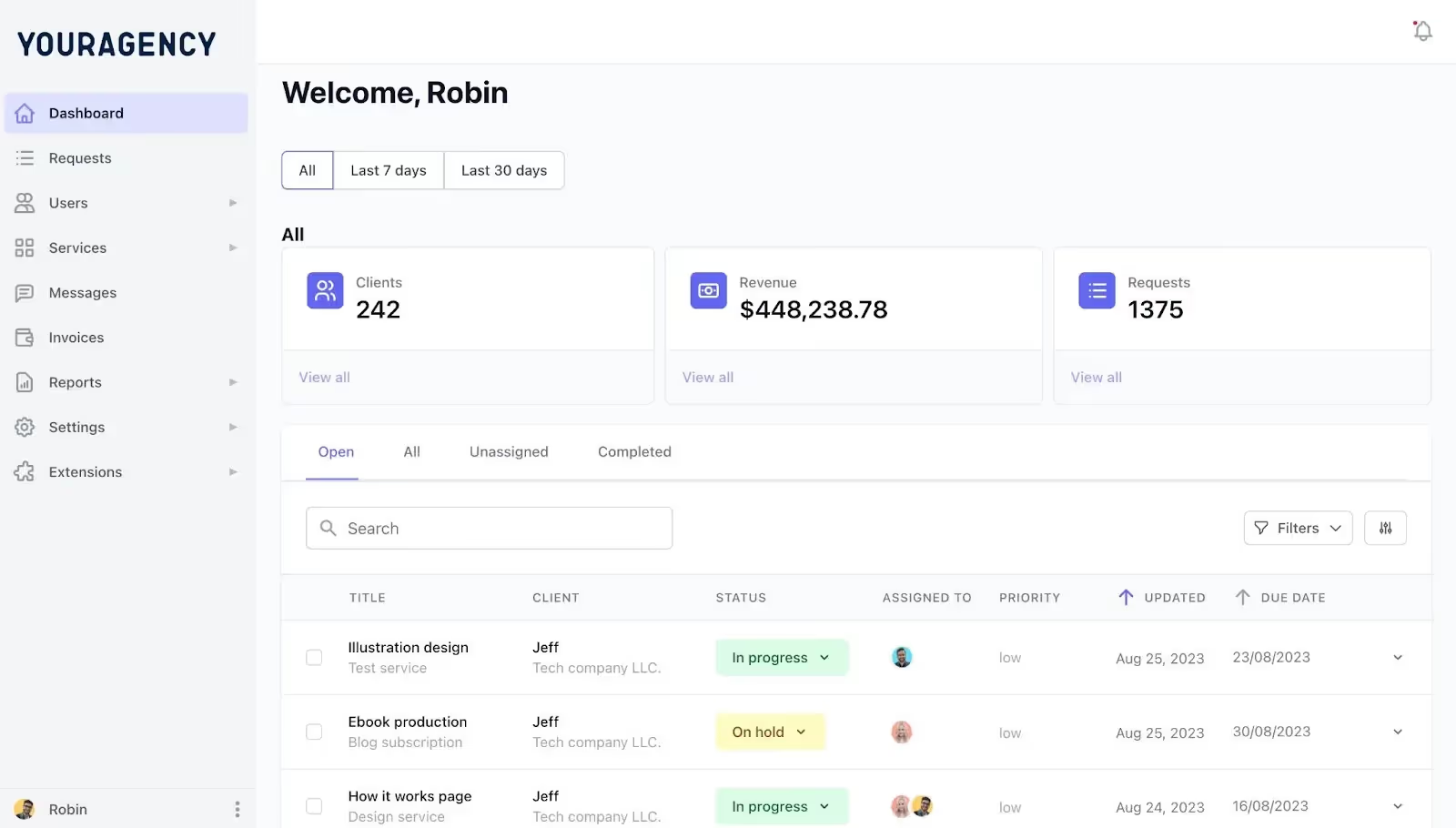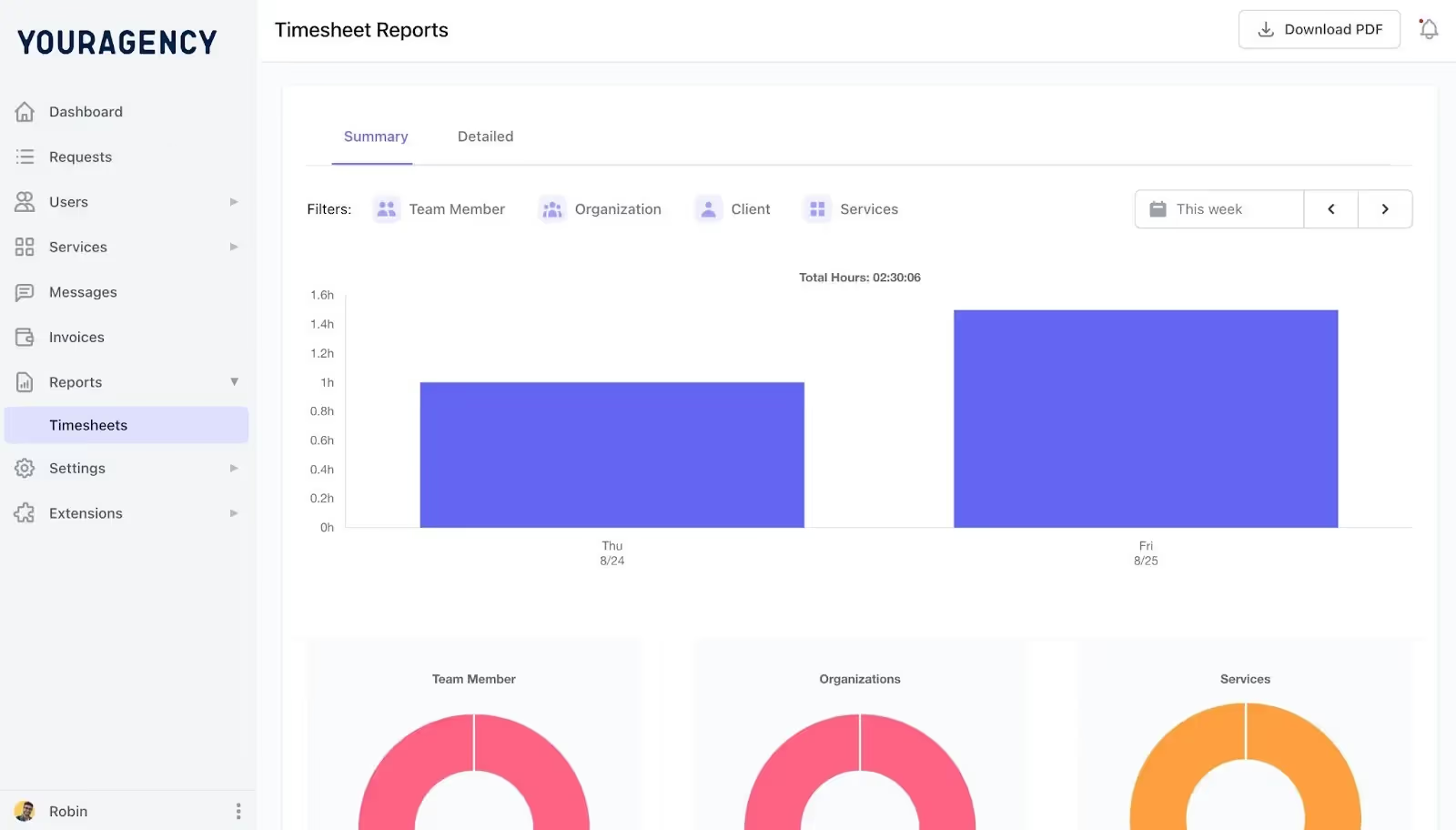8 Proven Ways to Reduce Subscription Churn for Agencies
Discover 8 proven strategies to reduce subscription churn in your creative agency. Learn how to improve client retention and grow your business with our guide.




Churn is part of the agency life cycle, they say. But when your agency has been bleeding clients faster than you can say “What’s going on?”, it’s all hands on deck to reduce subscription churn.
After all, acquiring new clients costs four times as much as retaining existing ones. So if your agency is quickly losing clients at a higher-than-average rate (most agencies report a churn rate between 2% and 8%), you know something wrong is going on–and you need to stop the bleeding fast.
And even if your churn rate is within the industry average, having a system in place to keep subscription churn under control will benefit your business's bottom line in the long run.
In this article, we’ll explore proven ways your team can effectively reduce customer churn rate, helping you get to the bottom of the issue before it drags the whole agency to its grave.
To refresh your memory, subscription churn is the percentage of clients who cancel or don’t renew your productized services over a set period. It's a critical metric for agencies because a high churn rate can directly impact revenue and client trust.
Here’s how it’s calculated:

Subscription Churn Rate = (Subscribers at the Start - Subscribers at the End) / Subscribers at the Start x 100
Knowing (and tracking) your agency’s subscription churn rate is a great starting point. You can’t stop the bleeding unless you know where it’s coming from.
However, dealing with the root cause of the sudden churn rate increase isn’t exactly clear-cut.
Sometimes it’s beyond your control (e.g., reduced cash flow or worsening inflation, which forces clients to tighten their control over their expenses). Most of the time, it’s the simple yet impactful things that have been under your nose all this time.
Once you know where your agency stands, you can now address the churn head-on with different strategies we’ll cover next.
One of the best ways to reduce client churn is to track what happens at each stage of your client’s journey. Think of it like mapping out your client’s story, from the onboarding excitement to the moments when they start considering leaving.
When you know where they’re dropping off, you can fix the problem before it escalates.
Set up a simple visualization tool that tracks key lifecycle moments—onboarding, setup, project reviews, and anniversaries. For example:
These checkpoints give you a clear picture of where things go wrong and why. Maybe it's a missed expectation after the first review, or maybe clients think they can handle things themselves after a project wraps up.
Here’s how to track and use client lifecycle events:
As marketing expert John Jantsch puts it, “If you hold a customer’s hand for 90 days, they’ll be loyal for life.”
In these first few months, it’s all about delivering quick wins—small victories that show clients immediate value. This is especially important in service-based businesses like SEO or marketing, where results take time.
By knocking out easy, impactful tasks early, you keep clients engaged and confident in your ability to deliver long-term results.
How to make the most of the first 90 days:
This early momentum is what keeps clients from second-guessing their decision to work with you and helps cement long-term loyalty.
Reducing churn isn’t just about delivering great results—it’s about maintaining strong, personal relationships with your clients.
Clients aren’t just paying for your services; they’re looking for a partner who understands their needs and keeps them informed every step of the way. If they don’t feel valued, they’ll start looking for someone who can provide that level of care.
Clear, consistent communication is essential to building these relationships. Regular check-ins, transparent updates, and quick responses to any challenges go a long way in creating trust. When clients feel like they’re in the loop and that their needs are being prioritized, they’re much less likely to churn.
Ways to strengthen client relationships:
Streamlining this level of communication can be challenging—especially as your agency grows and you handle more clients. That’s where tools like ManyRequests come in. With its all-in-one client portal, you can centralize everything from project briefs and task assignments to design revisions and approvals.

Instead of juggling multiple tools for time tracking, invoicing, and project updates, ManyRequests offers a single platform where project managers can access client requests, monitor designer performance, and track deadlines.
This not only keeps clients updated and involved but also helps your team operate more efficiently. You’ll save hours each month that would otherwise be spent updating separate tools or managing communication threads.
By giving your clients one source of truth and quick access to everything they need, you’re reinforcing the relationship and making it easier for them to stay loyal to your agency.
Upselling is an underutilized strategy that can significantly reduce churn and extend the lifespan of your client relationships. 55% of agencies don’t consistently upsell or cross-sell, missing a key opportunity to boost retention and add more value for their clients.
It’s not about selling for the sake of it—it’s about offering solutions that help your clients succeed. For instance, if you’re managing SEO for a client focused on backlinks, but notice they’re lacking a strong keyword strategy, that’s your moment to upsell a service that will drive even better results.
How to upsell without risking client trust:
Upselling is easier with ManyRequests, where agencies can create upsell packages and track client progress in one platform.
With a few clicks, you can create optional “add-ons”, offer them either as a one-off or recurring service, and bundle them with your core services so clients can easily pay for everything in one go.

Instead of juggling multiple tools and risking miscommunication, ManyRequests keeps everything organized—making it simpler to identify upsell opportunities and offer them at the right time. This way, you can present yourself as a one-stop solution, making it easier for clients to stick with your agency long-term.
When clients feel the pinch of tighter budgets, pricing can become a major reason for churn. Offering a temporary discount, like 30% off for three months, can keep them on board while you work on refining your pricing strategy or improving your services.
How to use flexible pricing to reduce churn:
With ManyRequests, you can easily create and manage discount codes, automating these offers when clients hit critical points, like cancellation.
You can choose the discount type (percentage or fixed), duration (once, repeating, or forever), expiry date, and the specific services it should apply to.

By providing select clients discount codes, your agency can keep them engaged while you optimize your pricing structure for long-term retention.
A client loyalty program not only strengthens relationships but also encourages long-term retention. While this strategy isn’t for every client, those who consistently bring in business deserve extra recognition.
For example, you could offer special perks like exclusive content, early access to new services, or even personalized insights that aren’t available to other clients. These small gestures can make your top clients feel valued, turning them into lifelong partners.
How to create a client loyalty program:
Clients want to feel heard, and gathering feedback is a powerful way to show that you genuinely care about their experience. By packaging this into a structured program—such as regular surveys or feedback forms—you create a system where clients know their opinions matter.
How to gather and use client feedback:
If you want a quicker way to collect client feedback directly tied to each completed project, ManyRequests has an automated solution for your agency.
With ManyRequests, clients can provide feedback within the portal as soon as a request is marked “Complete.” These reviews are accessible to both the assigned team members and agency management, allowing everyone to leverage the feedback to improve the team’s future outputs.

By enabling client reviews, you can easily gather detailed insights from your clients at the best time when everything is still fresh in their minds. This level of responsiveness shows clients that their voices are integral to your service quality, fostering loyalty and reducing churn.
Clients stick around when they feel like your agency truly understands their unique needs. Personalizing communication—whether it’s through tailored reports or specific touchpoints—shows clients that they’re more than just another account. This attention to detail builds stronger connections and boosts loyalty.
How to personalize client communications:
ManyRequests can make this entire process smoother and more personalized. With its built-in reporting features, you can easily generate custom reports that reflect each client’s specific needs.

You can also use the platform’s Kanban board to give clients a visual, up-to-date view of project stages and tasks. This helps you deliver a more tailored experience, making clients feel more involved and valued—key factors in building long-term loyalty and reducing churn.
Preventing churn is essential for maintaining steady revenue and fostering long-term growth. When clients leave, it creates gaps in your income, which can negatively impact cash flow, profitability, and the ability to scale your business.
Retaining existing customers is far more cost-effective than acquiring new ones, as loyal clients typically generate higher lifetime value. Reducing subscription churn helps build stronger relationships, enhances customer satisfaction, and improves overall business stability, ensuring that your services remain in demand over time.
The effects of customer churn include lost revenue, reduced profitability, and potential harm to your company’s reputation. A high churn rate indicates dissatisfaction or unmet expectations, which can discourage potential clients from signing up. Additionally, constant churn increases the costs associated with acquiring new customers, as it’s more expensive to attract new business than retain existing clients. Over time, high churn can limit your agency’s growth and ability to invest in new resources or services.
Several factors can affect customer churn, including poor customer service, unclear communication, pricing issues, and failure to deliver expected results. A lack of engagement or value from your product or service also contributes to churn.
Other factors include competition, where clients may find better offers elsewhere, and misalignment between client goals and your offerings. Tracking these factors and addressing them early can reduce the customer churn rate and improve retention.
Regular client communication significantly reduces the risk of churn. Keeping clients informed through personalized updates, project progress reports, and check-in calls shows them that their needs are being met.
Offering quick wins early in the relationship and soliciting feedback through surveys also helps. These activities create trust and engagement, ensuring clients feel valued and understood, which lowers their likelihood of leaving.
Reducing customer churn leads to higher profitability, increased customer loyalty, and long-term business growth.
When churn is low, your agency spends less on acquiring new clients and focuses more on enhancing relationships with existing ones. Loyal clients tend to refer more business and may be open to upselling opportunities, further increasing lifetime value.
By retaining customers, your agency builds a strong reputation and maintains consistent revenue, allowing you to scale effectively.
Reducing subscription churn is key to maintaining a healthy, thriving agency. From tracking client lifecycle events and focusing on the critical first 90 days to personalizing communication and offering flexible pricing, these strategies ensure your clients feel valued, supported, and engaged.
However, effectively managing these processes can be time-consuming and complex—especially as your agency grows.
With an all-in-one client portal, ManyRequests allows you to centralize project management, streamline communication, and easily track client feedback, helping you reduce churn without adding extra workload.
Ready to take your agency’s client retention to the next level?Try ManyRequests for free today and see how it can help reduce subscription churn for your agency.